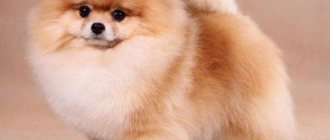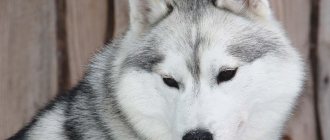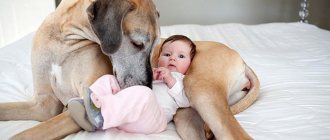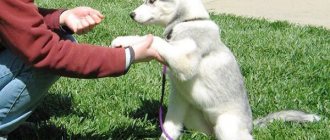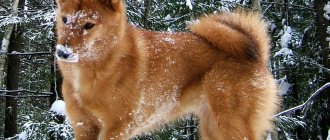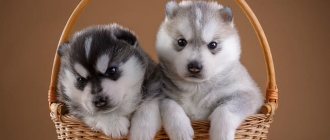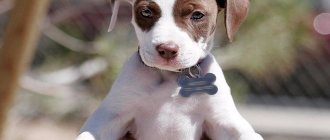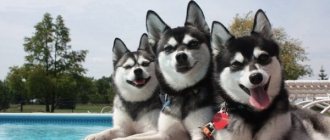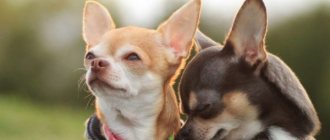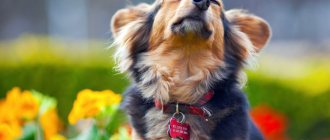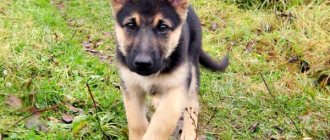Incredibly beautiful, smart, kind, sensitive and loving dogs of the Siberian Husky breed are the dream pets of many animal lovers. And this is truly a very attractive breed in every sense. But huskies require special treatment and care. In order for dogs to bring only joy to your home and become loyal human companions for many years, you need to know how to care for a husky.
In this material we will talk in detail about what caring for a husky consists of, what are the rules for keeping puppies and adult dogs of this breed, and whether a husky can live in a city apartment.
Features in the first days of life
If a person has a female husky in the house, then it is likely that the puppies will have to be looked after from the very first days of their life. Newborn babies are not much different from representatives of other breeds. They sleep and eat, growing up, they begin to play.
Husky is an amazingly beautiful dog
If an adult bitch has enough milk, then there should be no problems with nutrition. Also, the mother is able to independently care for her babies until they grow up and get stronger.
Starting from the 6th day, newborn puppies develop a trembling reflex, their body temperature begins to gradually rise, reaching normal. At the initial stages, the owner should pay attention to the place where the puppies are. If they stay with their mother, then the temperature in the room should be at least 20 degrees. In the case when there is no female, the room should be even warmer.
Important! The person should also ensure that all puppies receive enough milk. This is the only way they will grow and gain weight.
The weight of husky puppies doubles already on days 7-10, and after 6 weeks the weight of each kitten will increase 6-10 times its original weight.
Puppies should not be separated from their mother until they are at least 4-6 weeks old. At the same time, the baby must be in contact with the person for the entire specified time. This way he will be able to adapt to his new family faster.
In addition, the owner of the dogs must make sure that the puppies clearly know where their place is to sleep, feed, and which objects can be played with and which cannot. Also, from 4-6 weeks of age, babies need to be taken outside every time after eating. This way they will gradually get used to being patient until the walk.
Husky puppy: how to raise and care for it
Caring for a husky from the first days of life requires a lot of effort and attention on the part of the owner. The baby needs to be given as much time and care as possible. You will need to walk the baby, regularly feed, comb, bathe, educate, play, and so on.
How to train a puppy to toilet outside in a private house
The most difficult are the first 6 months. The owner should be patient and persistent in the matter of education. This is the only way to turn a mischievous baby into a loyal and devoted dog.
Important! As soon as the baby gets used to it and begins to respond to his name, the person will need to take on his upbringing and discipline.
Caring for a husky puppy first of all means learning the basic rules of behavior. Under no circumstances should the puppy be allowed to play with slippers, feet, boots, etc. If you do not stop this immediately, weaning an adult dog will be very problematic.
Owners should remember the following rules:
- The owner is the head of the house, he is the leader. This is the basis of education.
- You can't hit a dog. Violence in this matter is not acceptable. As a measure of influence, the puppy is taken by the withers and pressed to the floor so that he cannot move. After some time, the baby is released. This is the only way to indicate a dominant role.
- Alternatives need to be introduced. For example, you can’t chew shoes, but you can chew a special toy.
- Good behavior should always be rewarded.
- Commands must be carried out unquestioningly.
Owners should also remember that up to 6 months the puppy is still small. Until he reaches the required age, he should be taught the basic rules of behavior. Up to six months, babies become attached to family members and their immediate owner. When the puppy grows up, they begin to teach him the basic (simplest) commands.
Story
There are several versions of the origin of the breed. The most common opinion points to the northern origin of the dog.
Previously, “husky” was called an Eskimo. The point is not in the essence of the term, but in the consonance of the initial part of the words.
Four thousand years ago, Asians moved north with their pets. Then some domestic animals crossed with wolves. This is how the Siberian Husky came about. He became man's main assistant in harsh climatic regions. The Chukchi appreciated that the dog was unpretentious in its maintenance. He traveled hundreds of kilometers through snow and ice, eating whatever was given to him.
This is interesting: How to extend the life of a husky
According to historical facts, in frosty weather dogs warmed children with their warmth and did not allow them to freeze. The animal's appearance and character have remained almost unchanged since that time.
Husky in English means wheezing. A hoarse voice is characteristic of such animals.
Husky life in an apartment
Husky is a dog whose care and maintenance in an apartment differs significantly from staying in a private house. The problem is that in a confined space the animal will not be able to fully express its energy. In such a case, the owner should be prepared for minor damage.
How to care for a corgi: keeping in an apartment
As a countermeasure, you can install a special cage for the animal, with a separate soft place for sleeping. In this case, the dog will be able to stay at home alone, and the owner will not worry about damaged furniture or other items.
However, in any case, the animal needs long and regular walks. Simply going outside to let your pet go to the toilet will not work.
Important! In addition, an animal cannot be required to perform the function of a watchdog. Husky is a peaceful, friendly and very affectionate dog.
List of suitable nicknames
The pet's name must be chosen based on the animal's temperament.
Options for males:
- Siberia, Nero, Thunder, Zeus, Diamond, North;
- Fog, Buran, Shine, Nord.
Suitable nicknames for girls:
- Winter, Blizzard, Taiga, Elsa, Snowy;
- Umka, Zvezda, Bagheera, Yuna, Tina.
This is interesting: The most popular nicknames for husky boys and girls
Caring for a husky in the house and apartment: what to do with the fur
Husky in an apartment: can you keep it, care and maintenance?
Husky wool has unique properties that allow their family to survive even the most severe frosts (down to minus 60). With proper nutrition and care, shedding occurs once every six months in females, and every 1-1.5 years in males.
Grooming
Regular brushing will help avoid negative consequences in the form of a large amount of hair on the floor. Also, especially in apartment conditions, your pet needs to be bathed regularly.
Breed standard
The standard was created in the 30s, it was supplemented several times, but the basis for describing the appearance still remained the characteristics of a sled dog. From the photo of the husky you can see how muscular, strong and harmoniously built she is. Walks easily and gracefully.
Head
The head is proportionally folded, medium in size, triangular in shape. It is rounded at the top and tapers towards the eyes. The stop or transition from the forehead to the nose is well defined. The bridge of the nose is straight, the same length as the distance from the stop to the back of the head.
Muzzle
The muzzle is medium, cone-shaped, the cheekbones are well defined. The expression is good-natured, mischievous. From the photo you can see that the husky’s eyes are smart, interested, and beautiful.
Husky
They are almond-shaped, slightly slanting, and not widely spaced. The color is brown or light blue. Eyes may be different. The ears are medium, triangular, erect, directed upward. They are closely spaced, with rounded tips.
The jaw is strong, with black lips and a scissor bite. The teeth are sharp and strong. The nose is of the correct shape, its color can be any. It depends on the coat color. The standard allows brown, black with light veins, even flesh-colored.
Body type
The photo shows that the length of the body is greater than the height. The physique is harmonious, the gait is light and confident. The chest is wide and deep. These dogs have large hearts. The neck is muscular, of medium length; when moving, the head tilts forward. The back is flat, tapering towards the lower back.
Hunting
The tail is long, very fluffy, like a fox's, set below the level of the back. When the dog is calm, he hangs. When excited, it rises up. But it does not curl into a ring, but takes the shape of a sickle.
Limbs
The limbs are straight, set parallel. The elbows are pressed to the body, the thighs are muscular. The knees are mobile, located low, the joints are well defined. When moving, the forelimbs step easily, the hind limbs push off powerfully. The paws are more oval, heavily pubescent. The pads have thick skin, adapted for movement on hard crust.
Wool
Huskies have medium length fur. It is thick, with a fluffy undercoat, and not very hard. The warm coat allows the animal to sleep in the snow at temperatures down to 250.
Husky blue eyes
Color
The standard allows for different husky colors and patterns. All of them are common, but some are especially popular.
- The rarest and most beautiful is the white husky. This is not an albino, the eyes and nose are dark. The coat is snow-white, stains are not allowed.
- Gray-white and black-and-white colors are more common. The fur is darker on the back and upper part of the tail, and there is a mask on the muzzle. The undercoat may be silver.
- Red or chocolate is often combined with white.
- The fawn color looks beautiful. White belly, paws, beige top.
- The traditional color is wolf. Gray goes with dark gray and even black. There is a dark mask on the muzzle, lighter cheeks.
- The classic color is also black. White or gray spots and red tan are allowed, but not more than 25%.
There are individuals with silver, merle, tricolor, and piebald colors.
Failure to meet the breed standard
Each breed standard has clear characteristics. Dogs with defects are rejected and not allowed for breeding.
- very light refined head or rough;
- wide-set or close-set eyes;
- very wide or pointed muzzle;
- the tips of the ears are directed to the sides;
- short neck;
- a tightly curled or low-set tail;
- long or too coarse coat;
- mincing gait.
Husky on the street - is it safe?
Because of their unique fur, dogs of this breed can easily live in outdoor kennels throughout the year. However, in this case, a person should observe certain safety measures. In particular, the area where the dog walks should be fenced with a high fence, since huskies can easily jump over high obstacles.
You should definitely make sure that the animal has a place where it can hide during heat or snowfall. The dog needs a shelter or kennel. It’s good if in the summer the owner can let the pet into a cool room.
How long should you walk your husky per day?
Huskies have one more particularly important point in their care and maintenance, namely walking. As already mentioned, you can’t just take your dog outside for 5 minutes to go to the toilet. Active and energetic animals require a special approach.
If the animal is kept in an apartment, then walks should take at least 2 hours a day. This time can be divided into 1 hour in the morning and 1 hour in the evening. If a person is uncomfortable and needs to rush to work in the morning, then in the morning you can limit yourself to a 30-minute jog.
Important! Full physical activity is allowed only after the dog reaches the age of 1 year. By this time, the dog’s skeleton is already fully formed and it can frolic and jump without negative consequences for itself.
Walking the dog is very important
Health, typical diseases
Huskies are distinguished by good health and endurance and, with proper care, may not have health problems until a very old age. Average life expectancy is 12-15 years.
Representatives of this breed have some physiological characteristics that are considered pathologies in other dogs: increased blood clotting and an increase in heart size. This is due to the fact that the dogs were bred in northern regions with harsh climates, and their bodies were forced to adapt to heavy physical activity.
However, huskies have a number of genetic pathologies that pose an uncontrollable health threat. They are often diagnosed with hip dysplasia, a serious disease of the musculoskeletal system. The clinical picture is pronounced: the dog begins to limp, whine in pain, does not show activity and lies most of the time.
In the absence of appropriate treatment, the disease progresses and can lead to immobilization of the pet. At the initial stage, medication and physiotherapeutic treatment can help, but, unfortunately, dog owners often turn to the veterinarian only when the disease has taken an advanced form. In such cases, the only way to save the animal is surgery.
Huskies are also susceptible to ophthalmological diseases, such as progressive fiber atrophy and juvenile cataracts.
Fiber atrophy is characterized by dystrophic changes occurring in the ocular cornea. Typically, both eyes are affected. The prognosis for the disease is unfavorable - complete blindness.
Juvenile cataracts occur in young Huskies (under two years of age). A thickening in the form of a spot appears on the pupil, impairing vision. Surgery is indicated.
Grooming
Another important point in the question of how to care for a husky is the coat. Representatives of this breed cannot be cut. The wool is only combed out using a special brush.
First, the fur must be slightly moistened and then combed in the direction of hair growth from head to tail. Then the fur needs to be washed again, and after that the procedure is carried out against hair growth. After this, finally, the fur is laid. The last thing to tidy up is the tail.
Regular treatments will ensure that the fur does not mat. The formation of tangles is prevented.
Caring for ears, teeth and claws
The Siberian dog requires special care not only for its coat, but also for its teeth, ears and claws. As for teeth, it all depends on your diet. If the animal mainly eats dry food, then there is no need to remove plaque. The animal cleans its teeth on its own by chewing the granules.
If the pet eats mostly regular food, then the owner will have to take care of dental hygiene. For this, a special paste and toothbrush are used. The procedure should be carried out at least 1-2 times a week.
The dog's ears are examined at least once a week. If there is accumulated sulfur or dirt in the sinks, they should be wiped with a cotton swab dipped in hydrogen peroxide.
Attention! The owner should pay attention if the animal frequently shakes its head and scratches its ears. This may be a sign of an inflammatory process. In this case, you should immediately contact your veterinarian.
As for the claws, with an active lifestyle, they grind down on their own on asphalt or other hard surfaces. Otherwise, nails should be trimmed at least once a month.
Features of care in summer
The hot period requires special care for this breed. A person should follow the following recommendations:
- take the dog outside in the early morning and late evening when the heat subsides;
- If possible, stay in the shade of trees - walks in the park are best;
- provide constant access to water;
- regularly carry out water procedures - this is especially true for small puppies.
In summer, physical activity should be gentle, since the heat makes the dog get tired faster. At this time, walks can be reduced to 1 hour a day.
Important! Dogs cannot be cut during the summer. Every description of the Siberian breed boils down to the fact that the hair of these dogs is not intended for cutting.
Also, do not forget about protection against ticks. Starting in spring, insects become active and easily climb onto a dog running in thick grass. In this case, you can use special drops and spray. Also, after a walk, the animal’s fur must be inspected for parasites.
In terms of diet, in the summer it is necessary to observe moderation. An adult dog can determine how much it needs to eat, but the owner will have to decide for the baby.
Rescue in the heat
How to feed your pet correctly
Having figured out how to keep a husky, you should decide what to feed and how to properly organize the nutrition of an unusually beautiful dog.
During the first two months of life, the baby should eat at least 6 times a day. Its main diet is mother's milk.
Starting from 2 months, food intake is reduced to 5 times a day. A gradual reduction occurs until 10 months, when the dog can only eat 2 times a day. It is important to follow the regime. You need to feed your dog at the same time.
Dry food
Like any other dog, huskies can be fed dry food. In some cases, this diet will be healthier than natural food, since it contains all the necessary elements and substances. However, there is a basic rule here - the food must be of high quality.
Special food for the Husky breed is high in healthy fats and lower in carbohydrates. The following vitamin and mineral complexes must be included in the diet:
- A and C to maintain immunity;
- B for wool;
- D for muscles and joints;
- Calcium, Iron, Zinc, Iodine and others.
Important! If you have problems choosing the most suitable food, you should consult a veterinarian. A specialist will be able to choose the right diet for your dog, depending on gender, age and characteristics of the breed.
Husky food must be chosen carefully
Natural nutrition
If the owner prefers natural nutrition, then the following products must be included in the diet:
- lean meat;
- offal;
- sea fish;
- eggs (quail eggs work well);
- dairy products;
- vegetable and animal fats;
- vegetables, fruits, herbs;
- cereals;
- "sugar" seeds.
The animal must receive sufficient amounts of vitamins and minerals.
For reference! As an additional source of calcium, you can add a small amount of crushed eggshells to your food.
Prohibited Products
Regardless of the type of diet, there are a number of foods that are strictly prohibited for husky dogs.
These include:
- any types of sweets and confectionery;
- grapes or raisins;
- fatty meat, in particular pork or lamb;
- pickles, smoked meats, lard;
- citrus;
- milk;
- potato;
- River fish;
- tubular bones;
- bakery products;
- pasta;
- legumes;
- nuts.
Nutrition
When preparing a diet, you can use natural products and industrial feed. Factory provisions must be premium. Cheap options will not work. In high-quality nutrition, the amount of vitamins and microelements needed by the animal is calculated.
Natural food is preferable for huskies, however, it is difficult to properly balance it.
Huskies are able to digest even fatty meats.
Tips for creating a diet for your pet:
- 70% of the diet should be meat;
- Give boiled zucchini and pumpkin, fresh carrots and cucumbers;
- rice, buckwheat should be included in the daily menu, without salt;
- add grated apples to kefir and cottage cheese;
- mandatory - tripe, chicken kidneys;
- Give boiled sea fish weekly.
This type of nutrition must be enriched with vitamin complexes.
You should not feed your pet before bedtime. Dinner should be offered at least 1 hour before bedtime.
Feeding a Siberian Husky puppy is significantly different from feeding an adult. At 1 month, the baby lives on mother's milk. Later, he is gradually transferred to factory feed or natural products. Industrial granules are soaked in water or in low-fat meat broth.
If you choose homemade food, you should focus on boiled beef, turkey, and sea fish. Steamed vegetables, fresh fruits, cereals, cottage cheese are the basis of the menu.
On high-quality nutrition, the fluffy creature grows quickly, becomes stronger, and develops good immunity. Weight at 4 months will reach 14 kg.
Expert opinion
Anna Abramenko
An avid dog lover. Experience in veterinary medicine since 2009.
Ask a Question
It is forbidden to feed your pet sweets or food from the common table.
Puppy vaccination schedule and rules
Husky is a fairly strong breed of dog, characterized by good health. However, owners must vaccinate on time to avoid unpleasant consequences in the future.
The first vaccinations against the most common diseases, such as distemper or rabies, are given in the first 8-9 weeks. The procedure is repeated after 3-4 weeks. It should be remembered that 10 days before vaccination, the animal must be given an anti-worm remedy. Regular vaccinations for adult dogs are given once a year.
After vaccination, quarantine should be observed for 2 weeks. This is especially true for animals living in private homes. Only after this can the baby be taken out for a full walk.
Important! During the quarantine period, the puppy must be protected from drafts, stress and contact with other animals.
In addition to vaccination, do not forget about regularly cleaning the dog’s body of worms and blood-sucking parasites.
As you can understand, raising a healthy, strong and loyal husky is hard work that requires a lot of time and effort from the owner. If a person is not ready to give his pet due attention, then it is not worth having a breed of sled dogs. On the other hand, care and attention lead to the fact that a small fluffy puppy grows into a faithful and loving friend who will gladly keep you company on a walk and will wait at home.
Where should you keep your dog?
It is hot in a city apartment for a Siberian, and the fur and skin suffer from the high temperature and dry air. And the owners will have a hard time: wool will be everywhere, especially during the molting period. Huskies usually shed once a year, but in unfavorable conditions they can shed year-round. Only small species are suitable for an apartment; they are much easier to care for.
The best “home” for an active large dog is a spacious enclosure or kennel in the garden of a private house. To set up an enclosure you will need a chain-link mesh made of wire no thinner than 5 mm, preferably stainless steel. You cannot paint the fence so that the dog does not get poisoned (he will definitely try to bite the barrier).
Huskies love earthworks. They make tunnels with incredible speed and strive to escape at the first opportunity. Therefore, the mesh must be installed in the floor or foundation. The floor can be earthen or paving slabs. A canopy from rain and sun is a must. It is important that the enclosure is well ventilated. One, maximum two walls can be blank, the rest can be made of mesh.
